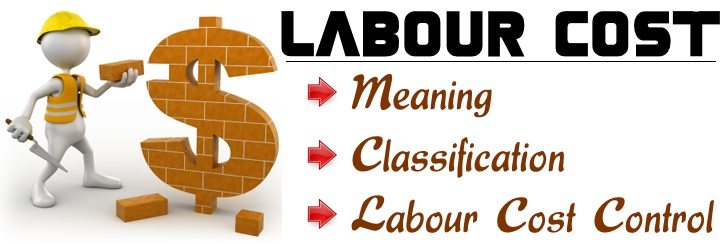Labour Cost | Meaning | Classification | Labour cost control
Table of Contents
What is Labour cost?
Labour cost represents human contribution. Labour cost is sensitive in nature. The reason is that the labour cost is fully based on the human behavior i.e. labour behavior.

The control of labour costs requires the control of the labour behavior. Therefore, the management should study human behaviour, performance of labour, time and motion study, labour turnover, labour approach in order to control the labour cost.
Labour cannot be stored for future reference. It is very much similar to the perishable nature of materials. Some materials may loose its quality and not used for the purpose of production. Such materials will be waste one. Likewise, once labour is lost, the same cannot be recovered and not effectively used in the days to come.
If labour is kept idle, the management should pay remuneration or wages for such idle time. Hence, the management incurred two losses. They are loss of labour working hours and monetary loss. Hence, the management is very keen in the control of labour cost.
Classification of Labour Cost
The labour cost may be classified in the following ways.
1. Direct Labour Cost
Direct Labour cost is that portion of salary or wage, which can be identified with and charged to a single unit cost of production.
Characteristics of Direct Labour Cost:
The direct labour cost has the following characteristics.
- It has direct relationship with the product or process or cost unit.
- It can be measured quantitatively.
- It is sufficiently material in amount.
2. Indirect Labour Cost
It is not identifiable within the production of goods and services even though directly incurred. These costs are incurred in the production place. Sometimes, some cost center may render service to the production departments or production activities. Such cost centers purchase, engineering and time keeping.
3. Controllable Labour Cost
A labour cost can be controlled by the management during production period and even during absence of production. A standard time and time rate may be fixed and request the labour to complete the job or order within such time. If so, the labour cost can be controlled to some extent.
4. Non-Controllable Labour Cost
A labour cost, which cannot be easily controlled by the management. A job or order can be completed by a group of labours. The efficiency of such group of labours differ in nature. A labour can use his/her efficiency in full as per the prevailing environment in the product place. If so, the cost cannot be controlled by the management.
Information required for Labour cost control
The following information is required for labour cost control effectively
1. Cost of recruitment of labour.
2. Training cost of workers.
3. Labour Turnover.
4. Idle Time.
5. Over Time.
6. Shift Work.
7. Labour Efficiency.
8. Number of workers.
9. Wastage.
10. Spoilage.
11.Wages Paid.
Methods or ways of Labour cost control
The management to control the labour cost effectively may exercise the following ways.
1. Proper production planning.
2. Fixing of standard time.
3. Fixing of clear-cut wage structure.
4. An agreement with workers.
5. Preparation of labour budgets i.e. Labour Cost Budget and Labour Hours Budget.
6. Performance reports of labour.
7. Fixing of specific incentive payment.
